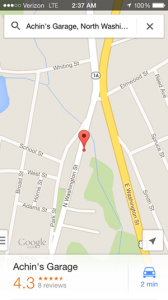
One of my clients – we’ll call him Greg – asked me a great question the other day:
He wanted to know whether to gear his review-encouragement efforts toward smartphone users or toward desktop / laptop users.
I knew the ins and outs of his situation, and gave him a quick answer. The essence of it was:
Focus on desktop reviewers if you have to “focus” on one, but encourage smartphone reviews to the extent customers find that easier.
That would be my general advice to you, even if I knew nothing about your situation.
But “mobile or desktop?” is a pregnant question. Answering it gets complicated fast.
For one thing, the device you ask customers to use can affect your review efforts in big ways:
- It affects when you ask for reviews. (Do you ask in-person, or by email, or both, or some other way?)
- It affects when customers can / will write the reviews (if they write them at all).
- It affects what you ask customers to do – it affects the kind of instructions you offer.
Why do those questions even matter? Can’t you just say to everyone, “Hey, we’d sure appreciate a review” and still get reviews from customers? Yes, and that can work OK.
But reviews are a numbers game. You’ll get more of them if you can ask customers to do something that’s easy for them, and at a time that’s the most convenient for them. Put a little thought into your approach and you might get 25 reviews for every 100 customers, rather than 3 for every 100.
Besides trial and error, the only way you’ll figure out which device(s) works better in your reviews campaign is to understand the pros and cons of each.
(By the way, I haven’t seen that one type of review inherently carries more “SEO benefit” than another.)
Pros of mobile reviews
- If customers say “Yes, I’ll review you” on the spot, it’s easy to ask them to follow through on the spot. They may even feel an obligation to do so.
- Some younger customers might find it more appealing to write a review on their phones.
- If you think some of your customers don’t own a full-sized computer at home, they’re probably used to doing everything on their phones – in which case writing a review for you is probably a cinch.
- Pretty much everyone has the Google Maps app already. (Which means all they need to write a review is a Google+ account.)

- Google may be less likely to filter a review written on a smartphone. (Thanks to Joy Hawkins for mentioning this point in her comment, below.)
- Pure speculation on my part: it’s possible that a review written through the Yelp app is less likely to be filtered. (Did I mention I’m just speculating?)
- Customers can check in at the same time. That may make the review less likely to die in the filter. And in Yelp that might give your rankings a slight bump.
Cons of mobile reviews
- You pretty much need an app – one specific to the site. Asking a customer on the spot to download and figure out how to use it may be a deal-killer.
- You have to direct customers to one specific site (see above point).
- Some sites where you might want reviews don’t have an app that makes it easy to write a review on a phone. Avvo (for lawyers) is an example. This can be a problem if your customers / clients / patients are concerned about privacy and you’re encouraging reviews on more-private sites.
- It’s trickier for you to provide helpful instructions for customers who might need them. (Although Darren’s mobile instructions for Google+ are kinda great.)
- Customers probably won’t write much in the review. Nobody’s going to consider a helpful review if it can fit in a fortune cookie.

- Writing a review on a phone usually isn’t convenient at the moment you ask – and by the time your customers get home they’ll probably forget.
- Some older customers may not have itchy phone fingers.
Pros of desktop / laptop reviews
- Customers don’t have to download and use an app. Assuming you know which specific site(s) you’ll be steering a given customer toward, your instructions can be one-size-fits-all.
- Simple PDF instructions (like mine) work like a charm.
- Customers are more likely to act on your email requests if they’re not on their phones. It’s still easier to read emails on a full screen and to type with a keyboard.
- Desktop / laptop may be easier for some older customers.
Cons of desktop / laptop reviews
- Customers have to do it at home (or at work). That may be several hours after you ask for a review.
- It’s easier to get distracted. Your request and their environment are at war for their attention.

- A review can seem a little more like a chore. Some people just find everything more enjoyable on their phones.
You should still get your sea legs with both devices. Learn what kinds of requests work well and not so well. Learn which sites bear the most fruit.
Wse the above points to try to create the easiest conditions for your customers from the start, and to troubleshoot and improve your process as you go.
—
Any pros / cons you’d add? What’s worked well (and not so well) for you?
Leave a comment!
Nice run through Phil. It certainly is a minefield of a topic once you scratch the surface and can be a barrier for SMBs to embrace because of the options/questions/pitfalls.
A key determinant of which site a customer should review you on is ‘what site do they have an account on already’. This may mean that you don’t get all your reviews on the sites you want, but is does lower the barriers to them leaving a review.
Maybe SMBs should pre-qualify the customers they work with by asking them if they have G+ or Yelp account and showing them the door if they don’t!
Hang on maybe that’s not a smart idea 🙂
That’s a great idea, Myles…it’s been my advice for the past couple of years!
I would also add that with Google reviews specifically, they are less likely to be filtered if left from a mobile phone since (provided the phone isn’t connected to wifi) each phone has a unique IP address and if the person is at your location – that is the best time to ask them to leave a review! If you tried doing this via a computer it would just get filtered b/c they would all have the same IP.
Great insight joy. I’m working with a Italian restaurant now and I’m going to suggest what you just wrote. Thanks a million. Awesome article Phil.
Thanks, Jason.
Thanks, Joy. Good call. I was thinking of adding that point, but then it occurred to me that I haven’t seen any first-hand evidence of that. I know you wrote a great post on filter-factors a year or two ago. Any chance you could elaborate on the times you’ve noticed a difference?
Any time I’ve ever recommended a client do it this way, I haven’t run into filter issues. Also, the only reviews of mine that have ever been filtered were ones that I’m 100% sure had IP conflicts. One was for a client, who is also my insurance agent and when I logged in from my work IP and left the review, it got filtered. When I did it from a hotel one time on a business trip, it posted just fine. When I was at a convention center for an SEO conference, it also got filtered but I believe I was connected to their wifi at the time. I also reposted later and it was fine.
Thanks, Joy. I added that as a point 🙂
My 1.5 cents:
People like to help people, especially ones they know, like and trust – which should be the point of reference the Review Requester is coming from.
If you’ve provided a good product/service on time at a fair price, then Step #1 is to ASK THEM TO DO YOU A FAVOR.
Most business owners never ask and never receive – “You miss 100% of the shots you don’t take.” – Wayne Gretzky
And WHEN you DO ask, give them the option (people love options) – either ask them which they would prefer or if sending via email include 2 links – one to instructions to leave mobile review and the other for desktop review.
Be sure to take the time to follow up and THANK THEM for their review – it does take time on their part, especially if this is the 1st time they’ve ever left a review.
Great rundown, Scott!
Excellent post Phil. If the job’s done well and you think there’s no reason why the customer wouldn’t help leave a positive review, perhaps you could have the apps loaded up on your own phone or iPad, ask the customer to login, write the review and log out when they are done. Getting those reviews on the stop will likely guarantee you one more review.
Thanks, Jackson.
I think that approach can be a little high-pressure, and it’s likely the reviews would get filtered.
Phil – I love the content, but I have to comment today on one of your illustrations – the fortune cookie. Not only does it reinforce your point, it’s really funny on its own. When it comes to reviews and devices, I’ll keep in mind a comment years ago by a colleague: “I used to be plastic, now I’m elastic…I’m flexible!”
I’ve discovered another “layer” of review information that seems to be increasingly important. While researching a bad review for a local restaurant (G+), I discovered that the reviewer had a fair amount of other reviews on his page AND he had 50 followers and over 8,000 page views. Yikes. Talk about bad or good reviews having “legs.” Thanks for another great post. Cheers – Edgar
Thanks, Edgar.
It does seem that bad reviews have the strongest legs.
Edgar Allen,
Absolutely love that comment about “i’m flexible” … makes total since. Yes reviews have legs :-).
Jason
This post (and the visuals) are on point, as usual. Thanks, Phil! A couple of additional points from my experience:
1) Notwithstanding Myles’s point about going G+/Yelp or bust, if you are trying to generate reviews on second-tier or niche review sites (and I know Phil agrees with me that you should ;), remember that Facebook and other third-party logins can increase conversions on those sites but are MUCH more likely to be used via desktop. On our phones, we use the Fb app, but on our desktop, we tend to be logged into Fb via the browser.
2) It’s worth analyzing how business is transacted when choosing a desktop or mobile review strategy (or both). Some businesses–like restaurants, car dealers, adult schools, etc.–have a natural lull in the action where the customer is still onsite but their experience is more or less concluded. These businesses have therefore historically favored onsite “kiosks” for collecting reviews. Now we know kiosks are BAD, but I’ve found that mobile can be a good substitute–help customers make use of their onsite downtime by helping you, and while their experience is still fresh!
3) Lastly, I’m not sure whether QR code adoption is pervasive enough yet to say that a QR code can grease the wheels of getting a decent number of customers to your review profiles on their mobile device, but consumer usage may finally be getting there–perhaps through marketer obstinance alone!
Great points, Jon. Especially #2. Thanks!
Phil,
Nice work as always. I’ve pinned to evernote for a more thorough digest later.
@Joy – Nice pickup on the mobile “trust” thing. Makes logical sense. Regarding the hotel issue, I was under the impression that if Google saw a bunch of reviews from the same IP (i.e. the hotel’s) they would filter these reviews as it would appear that they have a device soliciting reviews in the foyer (an iPad or something) – even though people may be making their own choice to review on their own device.
I work with a large Hotel client here in Australia, and it is one of the trickiest things to get right. Timing the asking for reviews so that it is at the point of checkout, but ensuring that the guest/customer is not using the internal wi-fi. I think once they’ve left the premises the chances of obtaining a review diminishes rapidly.
Dan
Thanks, Dan.
@Dan – I was referring to the review for my insurance agent. I left it while at a hotel and it stuck fine. Had I been reviewing the hotel from within the hotel, connected to their wifi, I am pretty certain it would be filtered. I don’t usually review hotels while I’m physically present there – I wait until I get home 🙂
So it would be awesome to create a QR code that will open up my business listing directly in the Google Maps app so that people could just scan it and place a review.
I found this page that talks about it, but am tripping on how to actually accomplish it.
https://www.pureoxygenmobile.com/googles-new-maps-ios-app-and-url-scheme/
Thoughts?
David, no one, in the history of the world, has ever scanned a QR code.
Ok, that might be stretching the truth a bit, but really, I don’t think many people bother with QR codes. At least on iPhone you have to download a special app to be able to use them, and very few people have bothered with that. My feelings on QR codes are summed up well on this site: https://shouldiuseaqrcode.com/
That’s only because you’ve never endorsed them Darren… 😀
HAHAH!!! Darren I could not agree more. They sound so cool but I’ve literally never seen someone scan one.
Hahaha
There are uses for QR’s. Maybe not on the business to consumer side but it works for consumer to business.
I work with a lot of restaurants and we use a QR code program with email marketing. It allows the staff to scan and see if it (the coupon) is still valid, how many redeemed, and how many times it has been used (if we allow multi uses per code). This is a great way to track the ROI of email marketing.
However, when I explain the technology 100% of the time the first question I get is “what a QR code?”
Marketers desperately hang onto a belief in QR codes because it really would be SO GREAT if people would just scan them, wouldn’t it? Trackable links to my digital content sprinkled throughout the physical world and immediately accessible to anyone with a smartphone?! Sign me up.
I actually still believe in the promise of QR codes, though, and usage is stubbornly growing: https://www.emarketer.com/Article/US-Ahead-of-Western-Europe-QR-Code-Usage/1009631
And I think that David’s use case may help drive usage. Here we have a new Google Maps URL schema designed to launch the GMaps app on your phone and point it to the particular location in the URL (e.g. by lat lon). Naysayers like to point out how cumbersome QR code usage is: you have to download a scanner app and learn how to point it at the little block. But the alternatives to scanning a QR code in David’s case (and others) may be more cumbersome still, and smartphone users may eventually welcome QR codes as “shortcuts” to everyday, app-specific tasks. Consider, for example, the scan-to-buy function of Scan.me, etc.
Jon–thanks for the words of encouragement. I do want people to interact with what I create. And I want them to be brand advocates and tell their friends and the internet and strangers, etc! But ultimately my question was about ways to lower the barriers to getting reviews. We are printing up programs for an event that’s the culmination of a year’s worth of lessons, and it seems just as cumbersome as Darren Shaw’s example link to print up a set of instructions for finding Google Maps and searching for my business and then posting a review. It really would be nice if people could just scan a barcode and voila!
Wow. I got schooled! I did some checking and seriously I gotta say I’m a bit bummed. I frankly wish phones were just smart enough to graphically recognize web addresses with the camera or something and just let you tap on the image of the address on your screen to go there. Especially the long ones with odd characters.
David, yeah, if the phone’s native camera app had QR code recognition automatically built in, then it will become useful, and I’d probably start using it. At the moment, it’s just too cumbersome to be effective.
I wouldn’t even bother. To me, QR = PITA.
Hi Phil
I find your expertise to be invaluable.
I was interested though in the comment about leaving reviews for hotels when the lady concerned, had returned home…..
Hayden
Thanks, Hayden!